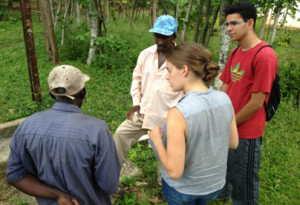DRIP (Dominican Republic Irrigation Project) started as a capstone project for Advanced Studies in Social Entrepreneurship during the spring of 2013. The initial vision for the project included the installation of a drip irrigation system to increase the yields of the crops being grown in Mata Los Indios, Dominican Republic—and ultimately the incomes of the people that live there. During development of DRIP, our team applied and was accepted to the prestigious Clinton Global Initiative University (CGIU) conference, after which we were thrilled to learn that our project would be fully financed, thanks to the generous support of Dr. Iacono of the Northeastern Office of Fellowships. All our hard work on DRIP was going to become much more than just diagrams and business plans—it was going to become reality!
Our first step with this new funding was to purchase the drip irrigation system through iDE (International Development Enterprises), which specializes in irrigation solutions for the rural poor. The simple system includes a human-powered treadle pump to extract the water from the ground, a tank to store the water, and a series of tubes and ropes that irrigate the water through the farm. Through weekly phone calls, we worked closely with the community leaders in Mata to make sure all aspects of the plan fit the community’s needs and capabilities.
Finally, thanks once again to the funding provided by Dr. Iacono, Habib and I were able to actually travel to the Dominican Republic in late May, and soon were in the field along with Professor Adomdza and the SEI field study students. After finally getting to meet face to face with Mesillé and Tomás, the president and vice president of Mata’s council of elders, and taking a tour of the actual farm, we sat down to discuss some of the challenges the community was facing with the project.
First, only about half of the land originally designated for the farm was currently being used, as the owner of that land could no longer afford to grant access to this land for free. Secondly, there was some malcontent in the community regarding the farm, due to a perception by some people that the leaders were not handing out enough food and were instead pocketing profits made from the sale of the farm’s crops. This problem was enhanced by the fact that very few community members were working the farm; they received handouts at the end of every harvest cycle, but since the leaders could not afford to pay them wages, they had no motivation to work. Yet, the elders argued, they could not continue doing it all by themselves. Compounding these issues was the impact of Hurricane Sandy, which caused them to lose an entire squash harvest this past fall and left them with no money to purchase inputs such as seed and fertilizer for a new round of planting. All that was left was 6,000 pesos (US$144) that they were determined to leave untouched as an emergency fund.
Just one day into the project, we were already working to shift our plans to address the challenges we had learned about. After another day of long meetings with Mesillé, Tomás, Ramón, Yolanda, Nena, and other community leaders, we came up with a solution: the establishment of a Labor Fund worth 38,000 DOP (US$925) to act as a starter fund through which community members would be paid for their labor on the farm (200 pesos for a half day, the standard and acceptable local wage for agricultural labor), in order to create an incentive for more of them to work the farm. We also brought a simple laminated daily schedule and dry erase markers in order for workers to sign up for shifts (5-10 per day) and make it easier to track hours worked and wages paid, as well as promoting general transparency.
On our final day in Mata, we tackled what we had originally come there to do: install the drip irrigation system! With our guidance, the elders assembled the system themselves, and quickly displayed that they understood how it worked and were excited to begin using it during the dry season. However, of course the day wasn’t without challenges. Though early discussions had led us to believe that the water table was in the 20-25 foot range, we came to realize that it was actually probably closer to 40-50 feet. This became our most difficult issue, as the pump we had purchased was not capable of reaching such depths. Thus, we arranged for a new electric pump to be installed next to the farm (17,500 DOP, or US$425) in combination with a new well (18,000 DOP, or US$450), which would be dug by a contractor trusted by the community elders.
Though we were only in Mata for a few whirlwind days, our job is not done yet. Moving forward, our tasks include continuing biweekly calls with the community leaders to check on the status of the irrigation system and the harvests, as well as production numbers, revenues, and expenses. This communication has been very positive so far. We have learned that the new well was successfully installed in mid-June, and they are thankful and optimistic about the new technology.
Our role in this project was to help supply the tools that the already-knowledgeable members of the Mata community need for success, and we feel confident that Mata’s leaders will use these tools to the best of their ability and work diligently to make this farm a success for the benefit of the community.



